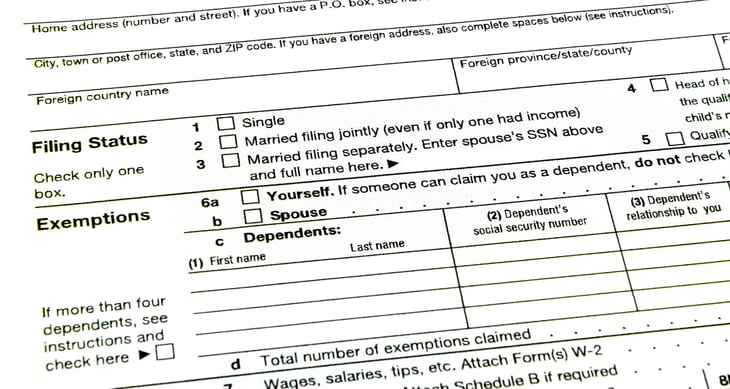
An estimated 40% of Americans didn’t pay any federal income taxes for the 2022 tax year.
“How can that be? Are they tax cheats?” you might be wondering as you stare at what seems like an unfairly high tax bill.
While cheaters exist, so do tens of millions of households that legally owe no taxes and aren’t even required to file a return.
The IRS uses income thresholds, technically known as “filing requirements,” to determine whether a taxpayer is required to submit a return.
Your exact filing threshold depends primarily on your tax-filing status and gross income. Age can also be a factor.
Here’s how it works.
What is your filing status?

Your federal tax-filing status can change from year to year, though this usually only happens in association with major life changes, such as getting married or divorced.
For the 2023 tax year, unless someone else claims you as a dependent on their return, your tax-filing status is either single, head of household, married filing jointly, married filing separately or qualifying surviving spouse.
Keep reading for a breakdown of the filing requirements for each of these statuses.
What is your gross income?

Again, whether you are required to file a federal tax return depends primarily on your tax-filing status and gross income. In this particular context, the IRS considers “gross income” to include “all income you receive in the form of money, goods, property, and services that isn’t exempt from tax, including any income from sources outside the United States or from the sale of your main home (even if you can exclude part or all of it).”
It can get a little tricky, though. For example, gross income excludes your Social Security benefits unless “(a) you’re married filing a separate return and you lived with your spouse at any time during 2023, or (b) one-half of your Social Security benefits plus your other gross income and any tax-exempt interest is more than $25,000 ($32,000 if married filing jointly),” according to the IRS.
If either of those situations applies to you, see the Form 1040 instructions for help figuring out the taxable portion of your Social Security benefits, which is the portion you must include in your gross income. Or, better yet, confirm it with your tax pro or financial advisor.
Are you 65 or older?

Your age may or may not affect your federal income tax filing requirement threshold. Basically, folks age 65 and older get a slightly higher threshold, just as they get a slightly higher standard deduction.
For the 2023 tax year, the IRS considers you to be 65 or older if you were born before Jan. 2, 1959 — in other words, if you were born on Jan. 1, 1959, or earlier.
Single

If your tax-filing status for the 2023 tax year is single and you were:
- Under age 65 last year: You are required to file a federal income tax return for 2023 if your gross income was $13,850 or more.
- Age 65 or older last year: You are required to file if your income was $15,700 or more.
Head of household

“Head of household” is a technical term to the IRS, with a more exacting definition than you might assume. You must meet specific requirements to use this filing status. They generally include being unmarried, paying for more than half the cost of keeping up a home and having a dependent or other qualifying person living with you.
If your filing status for 2023 is head of household and you were:
- Under age 65 last year: You are required to file a return for 2023 if your gross income was $20,800 or more.
- Age 65 or older last year: You are required to file if your income was $22,650 or more.
Married filing jointly

If your filing status for 2023 is married filing jointly and:
- Both you and your spouse were under age 65 last year: You are required to file a return for 2023 if your gross income (for both of you combined) was $27,700 or more.
- Only one of you was 65 or older last year: You are required to file if your combined gross income was $29,200 or more.
- Both of you were 65 or older last year: You are required to file if your combined gross income was $30,700 or more.
These thresholds assume that you lived with your spouse at the end of 2023 or, if your spouse died last year, that you lived with your spouse when they died.
If you didn’t live with your spouse at the end of the year or at the time of your spouse’s death in 2023, then you are required to file a return for 2023 if your gross income was at least $5 — regardless of your age. In other words, the IRS is effectively treating you as if your filing status for 2023 is married filing separately, which we’ll get to next.
Married filing separately

If your filing status for 2023 is married filing separately, whatever your age, you are required to file a return for 2023 if your gross income was $5 or more.
Yes, you read that right: just 5 bucks. The filing threshold for this filing status is drastically lower than the thresholds for all other filing statuses. It’s one of multiple ways in which the IRS treats married couples who file separate returns differently than other taxpayers. For another example, there are certain tax credits that you cannot qualify for if you file separately, even if you are otherwise eligible for the credits.
Qualifying surviving spouse

The qualifying surviving spouse status is generally reserved for widows and widowers whose spouse died two or three years ago.
Say a taxpayer’s spouse died in 2023. The IRS considers that taxpayer to have been married during the 2023 tax year and thus typically will allow the widow or widower to file as married filing jointly for 2023. But a taxpayer whose spouse died in 2022 or 2021 likely can use the qualifying surviving spouse status for 2023.
The filing threshold as well as the standard deduction for this filing status is essentially the same as that of married filing jointly — which is roughly twice that of single. So the qualifying surviving spouse status effectively postpones that drop-off for a couple of years, helping to ease the financial sting of losing a spouse.
If your filing status for 2023 is qualifying surviving spouse and you were:
- Under age 65 last year: You are required to file a return for 2023 if your gross income was $27,700 or more.
- Age 65 or older last year: You are required to file if your income was $29,200 or more.
If you are unsure whether you qualify for this or any other filing status, you can use the IRS’s free “What Is My Filing Status?” tool to get a better idea.
What about dependents?

Typically, dependents don’t file tax returns of their own and are simply listed as dependents on their parents’ or guardians’ returns. But when a dependent has income, the question of whether they must file can get tricky. The filing threshold depends on their marital status, the amount of their earned and unearned income, their age and whether they are blind.
To learn more, see Table 2 in IRS Publication 501.





Add a Comment
Our Policy: We welcome relevant and respectful comments in order to foster healthy and informative discussions. All other comments may be removed. Comments with links are automatically held for moderation.